In Photos: A Fuzzy 'Godzilla' & Other Snazzy Minerals
Godzilla!
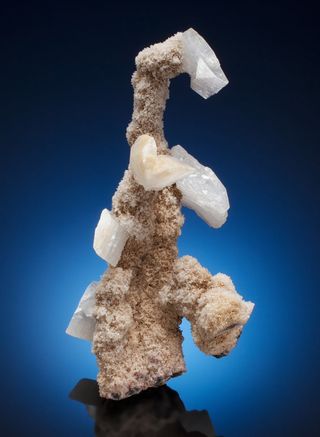
When giant gas bubbles in lava flows start to cool and solidify, sometimes the last stage before complete solidification involves 'lava-cicles' slowly dripping from the ceiling and a few freezing into forms reminiscent of coral branches or antlers. Cooler fluids later deposited microcrystals of Calcite and last in the sequence was the crystallization of the colorless, warped Heulandite prisms with a fine pearlescent luster. The specimen is in excellent condition for something that looks like Godzilla as a hockey goalie.
Overall Measurements: 5.82 x 2.0 x 2.63 inches (14.8 x 5.8 x 6.7 cm).
Estimate: $250+.
Dioptase
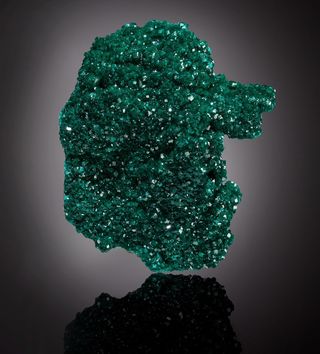
There is no one on this planet who doesn't instantly love Dioptase. Something magical takes place when you see this stunning Copper mineral - especially for the first time. Chemically, Dioptase is a Silicate of Copper, but not a common one. The best sources are African, with Kazakhstan running in second place. Historically, the most famous locality is the Tsumeb Mine in Namibia, but the mine is now exhausted and closed. That is where this enormous plate was mined many, many years ago. It displays classic Tsumeb style with hundreds of stout crystals of a transparent blue-green hue completely covering a Calcite matrix plate of typical reddish-brown color. The luster of the many crystals is brilliantly glassy.
Overall Measurements: 8 x 6.5 x 2.0 inches (20.2 x 16.7 x 5.1 cm).
Estimate: $150,000+.
Native Gold
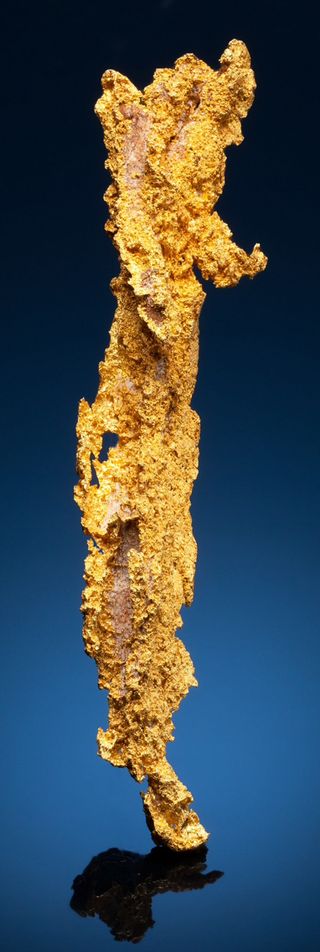
There is an increasing amount of evidence that some near surface gold is the product of biologically mediated deposition, involving plant derived compounds that assist in mobilization and deposition of metallic Gold. Some of the features displayed by this specimen, nicknamed "The Lightning Bolt" by the discoverers, are irregular cylindrical features running lengthwise down the piece. The sandy material from the walls of these features is very similar to material that accretes around tree roots in desert regions, where it has been associated with transport and deposition of Copper and Aluminum ions. Whether biological or strictly chemical, the appearance of this elongated structure revolves around numerous "fins" that are the edges of the hollow areas already mentioned. Luster is a combination of a hackly version on one side of the piece with a smoother "leaf" type on the obverse. The sandy 'matrix' is only present in the recesses of those same hollow areas. Total weight is 22.66 troy ounces.
Overall Measurements: 9.72 x 1.57 x 1.32 inches (24.7 x 4.0 x 3.37 cm).
Estimate: $150,000+.
Rhodochrosite
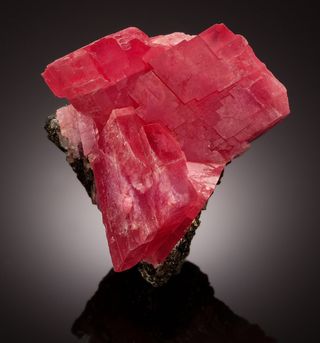
The story of the Sweet Home Mine and the lovely Rhodochrosites that have come from there are evidence of mining operations there were wildly successful in terms of the number of stunning specimens similar to this one. The mining and recovery operations have been over for some years now, and the availability of specimens is limited to the occasional specimen liberated from a collection. Several simple rhombs of deep strawberry red color, emerging from a dark Tetrahedrite and Pyrite matrix. Condition of the piece is excellent with some signs of contact with neighboring crystals prior to extraction in March of 1995.
Overall Measurements: 3.11 x 2.68 x 2.31 inches (7.91 x 6.81 x 5.87 cm).
Estimate: $20,000+.
Malachite
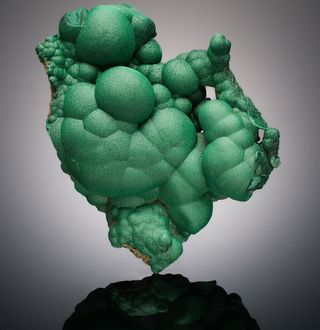
Overall Measurements: 5.0 x 4.0 x 2.0 inches (12.7 x 10.2 x 5.1 cm).
Estimate: $2,500+.
Uranocircite
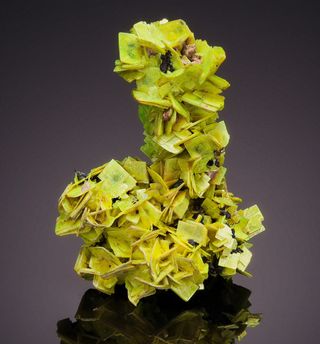
You do not need a U.V. light to see that this bladed group of crystals is highly fluorescent. Even in daylight, a glowing chartreuse coloration is visible. Uranocircite is quite similar to Autunite, with the exception of Barium substituting for Calcium in the structure; otherwise, both look alike. However, Uranocircite is quite a bit more rare.
Overall Measurements: 2.0 x 1.25 x 1.0 inches (5.08 x 3.18 x 2.54 cm).
Estimate: $450 +.
Variscite
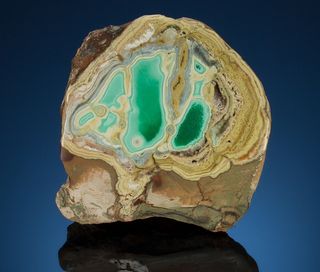
This beautiful little example of a 'phosphate nodule' containing Emerald green Variscite hails from the prime locality for these lapidary gems. The nodule has been sawn and polished to reveal the colorful interior since the exterior gives no hint as to the jewel color within.
Overall Measurements: 2.75 x 2.75 x 1.25 inches (6.99 x 6.99 x 3.18 cm).
Estimate: $600+.
Sign up for the Live Science daily newsletter now
Get the world’s most fascinating discoveries delivered straight to your inbox.
Hematite
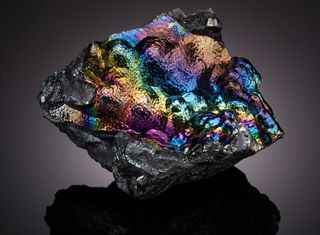
The powerful allure of this specimen is evidenced by the fact that the antique label accompanying it was penned by Johann Heinrich Heuland, otherwise known as "John Henry" Heuland - British collector, dealer and namesake for Heulandite - who was born in Bayreuth, Germany in 1778. Since he died in 1856, it is clear that this piece has been in play before then, at a minimum. The specimen was collected in the Iron mines on the Island of Elba, possibly around 1790, where it was plucked from obscurity like an ingénue discovered in a Hollywood drugstore. Whether it was found by a miner or a visiting mineralogist is functionally irrelevant; the piece speaks for itself.
Overall Measurements: 3.59 x 2.96 x 1.83 inches (9.12 x 7.54 x 4.65 cm).
Estimate: $2,500+.
Brazilianite
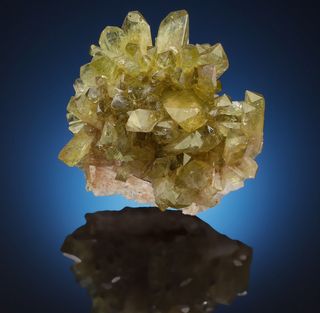
The average Brazilianite specimen is a single, loose crystal, usually somewhat 'dinged,' which makes undamaged matrix specimens bearing 40-50 individual crystals as rare as all get out. You almost never see groups containing more than ten. Which all boils down to: this is one very unique specimen on that count alone. As an aesthetic composition, it is an absolute explosion of glassy Brazilianite prisms sprouting like weeds from the tan and cream Feldspar matrix in a haphazard fashion. The transparency and brilliance of luster only serve to highlight subtle growth features present on certain crystal faces and the exotic shade of green contributes another dimension to the aesthetic impact of the group with its unique tint.
Overall Measurements: 4.31 x 4.09 x 2.39 inches (10.97 x 10.41 x 6.09 cm)
Estimate: $60,000 +.
Elmwood
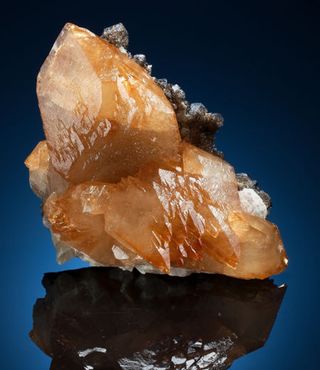
This magnificently dramatic Elmwood specimen displays a striking contrast in form and color, playing off the glassy, golden allure of its giant Calcite crystal group against a darkly metallic slab of Sphalerite crystals that rise like a wall, on one side of the massive composition. Many of the deep brown Sphalerites are freestanding, and all are implanted on a druzy layer of microcrystalline material of an off-white hue. The largest of the Sphalerites measures 1.19 inches (3.0 cm) across and is very close to being a "floater" crystal: one with no attachment to anything else. Nestled in a fissure off to one side of the base is a ball of a white bladed mineral, presumably Baryte that is also partially overcoated with sparkling, druzy Calcite.
Overall Measurements: 9.44 x 8.66 x 4.72 inches (24.0 x 22.0 x 12.0 cm).
Provenance: Rep. John Culberson Collection.
Estimate: $30,000+.











